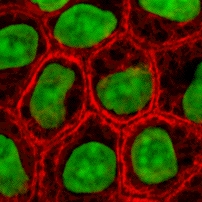
Back زرع الخلايا Arabic Kultura ćelija BS Cultiu cel·lular Catalan Buněčná kultura Czech Cellekultur Danish Zellkultur German Κυτταροκαλλιέργεια Greek Cultivo celular Spanish Rakukultuur Estonian کشت سلول Persian


Cell culture or tissue culture is the process by which cells are grown under controlled conditions, generally outside of their natural environment. After cells of interest have been isolated from living tissue, they can subsequently be maintained under carefully controlled conditions. They need to be kept at body temperature (37 °C) in an incubator.[1] These conditions vary for each cell type, but generally consist of a suitable vessel with a substrate or rich medium that supplies the essential nutrients (amino acids, carbohydrates, vitamins, minerals), growth factors, hormones, and gases (CO2, O2), and regulates the physio-chemical environment (pH buffer, osmotic pressure, temperature). Most cells require a surface or an artificial substrate to form an adherent culture as a monolayer (one single-cell thick), whereas others can be grown free floating in a medium as a suspension culture.[2] This is typically facilitated via use of a liquid, semi-solid, or solid growth medium, such as broth or agar. Tissue culture commonly refers to the culture of animal cells and tissues, with the more specific term plant tissue culture being used for plants. The lifespan of most cells is genetically determined, but some cell-culturing cells have been 'transformed' into immortal cells which will reproduce indefinitely if the optimal conditions are provided.
In practice, the term "cell culture" now refers to the culturing of cells derived from multicellular eukaryotes, especially animal cells, in contrast with other types of culture that also grow cells, such as plant tissue culture, fungal culture, and microbiological culture (of microbes). The historical development and methods of cell culture are closely interrelated with those of tissue culture and organ culture. Viral culture is also related, with cells as hosts for the viruses.
The laboratory technique of maintaining live cell lines (a population of cells descended from a single cell and containing the same genetic makeup) separated from their original tissue source became more robust in the middle 20th century.[3][4]
- ^ Taylor MW (2014). "A History of Cell Culture". Viruses and Man: A History of Interactions. Cham: Springer International Publishing. pp. 41–52. doi:10.1007/978-3-319-07758-1_3. ISBN 978-3-319-07757-4.
- ^ Harris AR, Peter L, Bellis J, Baum B, Kabla AJ, Charras GT (October 2012). "Characterizing the mechanics of cultured cell monolayers". Proceedings of the National Academy of Sciences of the United States of America. 109 (41): 16449–16454. Bibcode:2012PNAS..10916449H. doi:10.1073/pnas.1213301109. PMC 3478631. PMID 22991459.
- ^ "Some landmarks in the development of tissue and cell culture". Retrieved 19 April 2006.
- ^ "Cell Culture". Retrieved 19 April 2006.